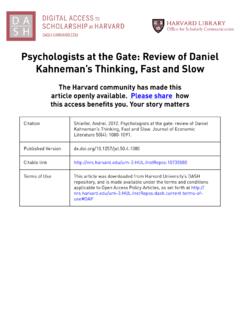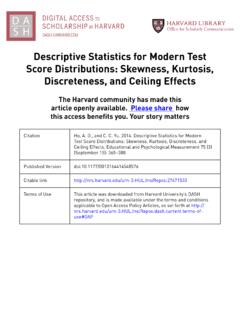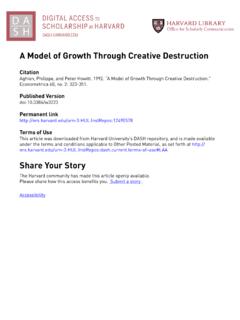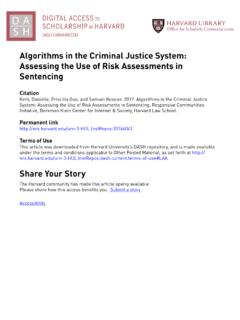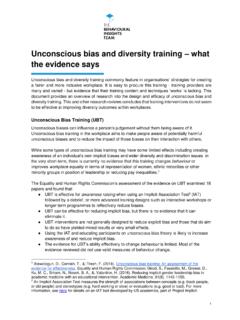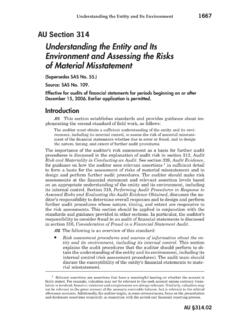Transcription of Principles of (Behavioral) Economics - Harvard University
1 Principles of ( behavioral ) EconomicsCitationLaibson, David, and John A. List. 2015. Principles of ( behavioral ) Economics . American economic Review 105 (5) (May): 385 390. :30805504 Terms of UseThis article was downloaded from Harvard University s DASH repository, and is made available under the terms and conditions applicable to Other Posted Material, as set forth at #LAAS hare Your StoryThe Harvard community has made this article openly share how this access benefits you. Submit a story .Accessibility385 American economic Review: Papers & Proceedings 2015, 105(5): 385 390 are many great ways to incorporate behavioral Economics in a first-year under-graduate Economics class , the course that is typically called Principles of Economics . Our preferred approach integrates behavioral Economics throughout the course ( , see Acemoglu, Laibson, and List 2015).
2 With the integrated approach, behavioral content plays a role in many of the chapters of the Principles of Economics curriculum, including chapters on optimization, equilibrium, game theory, inter-temporal choice, probability and risk, social preferences, household finance, the labor mar-ket, financial intermediation, monetary policy, economic fluctuations, and financial prefer the integrated approach because it enables the behavioral insights to show up where they are conceptually most relevant. By illustra-tion, it is best to combine a discussion of down-ward nominal wage rigidity ( , the idea that workers strongly resist nominal wage declines) with the overall discussion of the labor or not an instructor integrates behav-ioral Economics throughout the Principles of Economics course, it makes sense to pull cen-tral materials together and dedicate a lecture (or more) to a focused discussion of behavioral Economics .
3 This note describes our approach to such a lecture, emphasizing six key Principles of behavioral Economics IN THE CLASSROOMP rinciples of ( behavioral ) Economics By David Laibson and John A. List** Laibson: Department of Economics , Harvard University , Cambridge, MA 02138 and NBER (e-mail: List: University of Chicago, 1126 E. 59th Street, Chicago, IL 60637 and NBER (e-mail: We thank Saurabh Bhargava, Brigitte Madrian, and Ted O Donoghue for helpful suggestions and feedback. We are also grateful to Daron Acemoglu, who directly contributed, as our Economics coauthor, to many of the pedagogical approaches discussed here. Go to to visit the article page for additional materials and author disclo-sure statement(s).Our choice of content for a behavioral lecture is motivated by three factors.))
4 First, we include ideas that are conceptually important. Second, we include material that is practically import-ant and personally relevant to our students we have found that such content resonates long after the course ends. Third, we include content that relates to what has been (or will be) taught in the rest of the course, and therefore serves as a com-plement. We want students to see that behavioral Economics is an integrated part of Economics , not a freak show that is isolated from the standard ingredients in the rest of the Economics paper summarizes our approach to such a focused behavioral lecture. In Section I, we define behavioral Economics and place it in his-torical context. In Section II, we introduce six modular Principles that can be used to teach behavioral Economics .
5 We provide PowerPoint notes on our home pages, which instructors should feel free to edit and behavioral Economics DefinedBehavioral Economics uses variants of tradi-tional economic assumptions (often with a psy-chological motivation) to explain and predict behavior, and to provide policy we teach our students this definition of behavioral Economics , we like to emphasize that behavioral Economics is a series of amend-ments to, not a rejection of, traditional econom-ics. We illustrate the complementarities between traditional and behavioral Economics with an example: if you want to get from Chicago to the bleachers of Fenway Park to watch the Boston Red Sox, standard Economics will get you to Cambridge, or even Boston University (which is adjacent to Fenway), but you may need behav-ioral Economics to take the final steps and find your seat in the 2015386 AEA PAPERS AND PROCEEDINGSIn this way, behavioral Economics augments standard economic analysis.
6 behavioral eco-nomics adopts and refines the three core prin-ciples of Economics : optimization, equilibrium, and empiricism (Acemoglu, Laibson, and List 2015). Both traditional and behavioral econo-mists believe that (i) people try to choose their best feasible option (optimization); (ii) people try to choose their best feasible option when interacting with others (equilibrium); and (iii) models need to be tested with data (empiricism). In the next section we provide some examples of how behavioral Economics refines economic a historical perspective, the big bang for behavioral Economics was a paper on pref-erences over gambles written by two psycholo-gists, Daniel Kahneman and Amos Tversky, in 1979. So modern behavioral Economics is a lot younger than the rest of the field of , behavioral concepts have always played a part in economic analysis (though they didn t always have that headline name).
7 As Ashraf, Camerer, and Loewenstein (2005) point out, Adam Smith frequently wrote about the psychology of decision-making, including the tension between a person s passions and their rational deliberations, which Smith refers to as the impartial spectator. The impar-tial spectator is the source of self-denial, of self-government, of that command of the pas-sions which subjects all the movements of our nature to what our own dignity and honour, and the propriety of our own conduct require (Smith 1759 [1984], I, i, v, 23). Psychological assumptions are as old as Economics Six Principles of behavioral EconomicsThese Principles are modular, so instructors can pick whatever subset matches their interests and their time budget. In our experience, all six Principles can be covered in a hour lecture, but that is not what we recommend.
8 If you wish to cover all six Principles , we suggest allotting two each principle we present a series of examples that illustrate and explain the princi-ple and engage first-year Economics students. We ve included more examples than you will probably be able to use, so we encourage you to pick among 1: People try to choose the best fea-sible option, but they sometimes don t other words, people try to make the optimal choice they are optimizers but they some-times make mistakes. It s important to empha-size that these mistakes are partially predictable. One of the key explanatory factors is experi-ence and training: experienced decision-makers tend to make better choices than inexperienced illustrate these ideas, we use a range of examples.
9 If students play the p-beauty contest game twice, they will see behavior converging toward the Nash equilibrium. The game is sim-ple enough to be played in class (or on the web before class). But even if you don t actually play the game in class, you ll be able to show the stu-dents easy to understand data ( , Nagel 1995) that illustrates this you prefer to teach the first principle using field data, you could explain that credit card users pay fewer and fewer fees for instance, late payment fees the more experience they have with their card (Agarwal et al. 2013). Likewise, consumers switch telephone plans, moving toward the best one, as they gain experi-ence (Miravete 2003).These examples all illustrate that everyone choosing optimally is a better prediction for experienced decision-makers than for inexperi-enced first principle should also be used to explain why learning Economics is so useful to students.
10 Economics courses have the tan-gible benefit of increasing the optimality of the students own decisions. We tell our stu-dents that learning Economics turns you into a decision-maker who is more likely to choose the best feasible alternative. By taking Economics , you become a more skilled optimizer. PRINCIPLE 2: People care (in part) about how their circumstances compare to reference points. For example, a reference point could be the amount of money a person expected to earn during summer break, or the amount of money that she started with when she entered a casino, or the price she paid for 100 shares of Apple stock, or the price she paid for her home. It matters whether a person is losing or gaining relative to their refer-ence point. Losses get far more weight than gains, which is called loss aversion (Kahneman and Tversky 1979).
